Assessing Human Mobility and Its Climatic and Socioeconomic Factors for Sustainable Development in Sub-Saharan Africa
Abstract
:1. Introduction
2. Methods
2.1. Data
2.2. Statistical Analysis
2.2.1. Mobility Clustering
2.2.2. Determinant Analysis
3. Results and Discussion
3.1. Human Mobility in Sub-Saharan Africa
3.2. Climatic and Socioeconomic Effects on Human Mobility
3.3. Implication for Sustainable Development in a Post-Pandemic Era
4. Conclusions
Supplementary Materials
Author Contributions
Funding
Institutional Review Board Statement
Informed Consent Statement
Data Availability Statement
Conflicts of Interest
References
- United Nations Statistics Division. Global Indicator Framework for the Sustainable Development Goals and Targets of the 2030 Agenda for Sustainable Development Report No. A/RES/71/313; United Nations Statistics Division: New York, NY, USA, 2017. [Google Scholar]
- Hoffmann, R.; Šedová, B.; Vinke, K. Improving the Evidence Base: A Methodological Review of the Quantitative Climate Migration Literature. Glob. Environ. Chang. 2021, 71, 102367. [Google Scholar] [CrossRef]
- Black, R.; Adger, W.N.; Arnell, N.W.; Dercon, S.; Geddes, A.; Thomas, D. The Effect of Environmental Change on Human Migration. Glob. Environ. Chang. 2011, 21, S3–S11. [Google Scholar] [CrossRef]
- Boas, I.; Kloppenburg, S.; van Leeuwen, J.; Lamers, M. Environmental Mobilities: An Alternative Lens to Global Environmental Governance. Glob. Environ. Politics 2018, 18, 107–126. [Google Scholar] [CrossRef]
- Sheller, M.; Urry, J. The New Mobilities Paradigm. Environ. Plan. Econ. Space 2006, 38, 207–226. [Google Scholar] [CrossRef] [Green Version]
- Sheller, M. Automotive Emotions: Feeling the Car. Theory Cult. Soc. 2004, 21, 221–242. [Google Scholar] [CrossRef]
- de Haas, H. Paradoxes of Migration and Development. In Routledge Handbook of Migration and Development, 1st ed.; Bastia, T., Skeldon, R., Eds.; Routledge: New York, NY, USA, 2020; pp. 17–31. ISBN 978-1-315-27690-8. [Google Scholar]
- Salazar, N.B. Towards an Anthropology of Cultural Mobilities. Crossings J. Migr. Cult. 2010, 1, 53–68. [Google Scholar] [CrossRef] [Green Version]
- Guadagno, L. Human Mobility in a Socio-Environmental Context: Complex Effects on Environmental Risk. In Identifying Emerging Issues in Disaster Risk Reduction, Migration, Climate Change and Sustainable Development; Sudmeier-Rieux, K., Fernández, M., Penna, I.M., Jaboyedoff, M., Gaillard, J.C., Eds.; Springer International Publishing: Cham, Switzerland, 2017; pp. 13–31. ISBN 978-3-319-33878-1. [Google Scholar]
- Li, Q.; Samimi, C. Sub-Saharan Africa’s International Migration and Sustainable Development under Climate Change. In Proceedings of the EGU22, Vienna, Austria, 23–27 May 2022; Volume 11529. [Google Scholar]
- Li, Q.; Samimi, C. Sub-Saharan Africa’s International Migration Constrains Its Sustainable Development under Climate Change. Sustain. Sci. 2022, 17, 1873–1897. [Google Scholar] [CrossRef]
- IOM’s GMDAC Migration and Development, Sustainable Development Goals. Available online: https://migrationdataportal.org/themes/sustainable-development-goals-sdgs-0 (accessed on 20 September 2020).
- Deutsche Gesellschaft für Internationale Zusammenarbeit (GIZ). GmbH Human Mobility in the Context of Climate Change: Migration, Displacement and Planned Relocation in the Eastern Caribbean, the Pacific and the Philippines; Deutsche Gesellschaft für Internationale Zusammenarbeit (GIZ): Bonn, Germany, 2019. [Google Scholar]
- Franco Gavonel, M.; Adger, W.N.; Safra de Campos, R.; Boyd, E.; Carr, E.R.; Fábos, A.; Fransen, S.; Jolivet, D.; Zickgraf, C.; Codjoe, S.N.; et al. The Migration-Sustainability Paradox: Transformations in Mobile Worlds. Curr. Opin. Environ. Sustain. 2021, 49, 98–109. [Google Scholar] [CrossRef]
- International Organization for Migration. Human Mobility Shaping Vulnerability and Resilience to Disasters: Migration, Displacement and Disaster Risk Reduction; International Organization for Migration: Geneva, Switzerland, 2014. [Google Scholar]
- United Nations General Assembly. United Nations Transforming Our World: The 2030 Agenda for Sustainable Development; United Nations General Assembly: New York, NY, USA, 2015. [Google Scholar]
- Arnold, R.D.; Wade, J.P. A Definition of Systems Thinking: A Systems Approach. Procedia Comput. Sci. 2015, 44, 669–678. [Google Scholar] [CrossRef] [Green Version]
- Assaraf, O.B.-Z.; Orion, N. Development of System Thinking Skills in the Context of Earth System Education. J. Res. Sci. Teach. 2005, 42, 518–560. [Google Scholar] [CrossRef]
- Stalter, A.M.; Phillips, J.M.; Ruggiero, J.S.; Scardaville, D.L.; Merriam, D.; Dolansky, M.A.; Goldschmidt, K.A.; Wiggs, C.M.; Winegardner, S. A Concept Analysis of Systems Thinking. Nurs. Forum 2017, 52, 323–330. [Google Scholar] [CrossRef] [PubMed]
- Bell, M.; Ward, G. Comparing Temporary Mobility with Permanent Migration. Tour. Geogr. 2000, 2, 87–107. [Google Scholar] [CrossRef]
- Wiederkehr, C.; Schröter, M.; Adams, H.; Seppelt, R.; Hermans, K. How Does Nature Contribute to Human Mobility? A Conceptual Framework and Qualitative Analysis. Ecol. Soc. 2019, 24, art31. [Google Scholar] [CrossRef]
- Li, Q.; Ma, H.; Xu, Z.; Feng, H.; Bellingrath-Kimura, S. Balancing Socioeconomic Development with Ecological Conservation towards Rural Sustainability: A Cas. Int. J. Sustain. Dev. World Ecol. 2021, 29, 246–262. [Google Scholar] [CrossRef]
- De Haas, H. International Migration, Remittances and Development: Myths and Facts. Third World Q. 2005, 26, 1269–1284. [Google Scholar] [CrossRef]
- Guadagno, L. Human Mobility in the Sendai Framework for Disaster Risk Reduction. Int. J. Disaster Risk Sci. 2016, 7, 30–40. [Google Scholar] [CrossRef] [Green Version]
- Boas, I.; Farbotko, C.; Adams, H.; Sterly, H.; Bush, S.; van der Geest, K.; Wiegel, H.; Ashraf, H.; Baldwin, A.; Bettini, G.; et al. Climate Migration Myths. Nat. Clim. Chang. 2019, 9, 901–903. [Google Scholar] [CrossRef] [Green Version]
- Disney, G.; Wiśniowski, A.; Forster, J.J.; Smith, P.W.F.; Bijak, J. Evaluation of Existing Migration Forecasting Methods and Models. In Report for the Migration Advisory Committee: Commissioned Research; ESRC Centre for Population Change, University of Southampton: Southampton, UK, 2015; p. 66. [Google Scholar]
- Li, Z.; Huang, X.; Hu, T.; Ning, H.; Ye, X.; Huang, B.; Li, X. ODT FLOW: Extracting, Analyzing, and Sharing Multi-Source Multi-Scale Human Mobility. PLoS ONE 2021, 16, e0255259. [Google Scholar] [CrossRef]
- Ruktanonchai, N.W.; Ruktanonchai, C.W.; Floyd, J.R.; Tatem, A.J. Using Google Location History Data to Quantify Fine-Scale Human Mobility. Int. J. Health Geogr. 2018, 17, 28. [Google Scholar] [CrossRef] [Green Version]
- Willekens, F. Monitoring International Migration Flows in Europe: Towards a Statistical Data Base Combining Data from Different Sources. Eur. J. Popul. 1994, 10, 1–42. [Google Scholar] [CrossRef]
- Afifi, T.; Milan, A.; Etzold, B.; Schraven, B.; Rademacher-Schulz, C.; Sakdapolrak, P.; Reif, A.; van der Geest, K.; Warner, K. Human Mobility in Response to Rainfall Variability: Opportunities for Migration as a Successful Adaptation Strategy in Eight Case Studies. Migr. Dev. 2016, 5, 254–274. [Google Scholar] [CrossRef]
- Borderon, M.; Sakdapolrak, P.; Muttarak, R.; Kebede, E.; Pagogna, R.; Sporer, E. Migration Influenced by Environmental Change in Africa: A Systematic Review of Empirical Evidence. Demogr. Res. 2019, 41, 491–544. [Google Scholar] [CrossRef] [Green Version]
- Grau, H.R.; Aide, T.M. Are Rural–Urban Migration and Sustainable Development Compatible in Mountain Systems? Mt. Res. Dev. 2007, 27, 119–123. [Google Scholar] [CrossRef] [Green Version]
- Yang, X.; Zhao, Z.; Lu, S. Exploring Spatial-Temporal Patterns of Urban Human Mobility Hotspots. Sustainability 2016, 8, 674. [Google Scholar] [CrossRef] [Green Version]
- Barbosa, H.; Hazarie, S.; Dickinson, B.; Bassolas, A.; Frank, A.; Kautz, H.; Sadilek, A.; Ramasco, J.J.; Ghoshal, G. Uncovering the Socioeconomic Facets of Human Mobility. Sci. Rep. 2021, 11, 8616. [Google Scholar] [CrossRef]
- Deng, H.; Aldrich, D.P.; Danziger, M.M.; Gao, J.; Phillips, N.E.; Cornelius, S.P.; Wang, Q.R. High-Resolution Human Mobility Data Reveal Race and Wealth Disparities in Disaster Evacuation Patterns. Humanit. Soc. Sci. Commun. 2021, 8, 144. [Google Scholar] [CrossRef]
- Wang, Q.; Phillips, N.E.; Small, M.L.; Sampson, R.J. Urban Mobility and Neighborhood Isolation in America’s 50 Largest Cities. Proc. Natl. Acad. Sci. USA 2018, 115, 7735–7740. [Google Scholar] [CrossRef] [Green Version]
- Pappalardo, L.; Pedreschi, D.; Smoreda, Z.; Giannotti, F. Using Big Data to Study the Link between Human Mobility and Socio-Economic Development. In Proceedings of the 2015 IEEE International Conference on Big Data (Big Data), Santa Clara, CA, USA, 29 October–1 November 2015; IEEE: Santa Clara, CA, USA, 2015; pp. 871–878. [Google Scholar]
- Lu, M.; Schmitz, O.; de Hoogh, K.; Hoek, G.; Li, Q.; Karssenberg, D. Integrating Statistical and Agent-Based Modelling for Activity-Based Ambient Air Pollution Exposure Assessment. Environ. Model. Softw. 2022, 158, 105555. [Google Scholar] [CrossRef]
- McAuliffe, M.; Khadria, B.; Bauloz, C. World Migration Report 2020; IOM: Geneva, Switzerland, 2019; ISBN 978-92-9068-789-4. [Google Scholar]
- Adger, W.N.; Crépin, A.-S.; Folke, C.; Ospina, D.; Chapin, F.S.; Segerson, K.; Seto, K.C.; Anderies, J.M.; Barrett, S.; Bennett, E.M.; et al. Urbanization, Migration, and Adaptation to Climate Change. One Earth 2020, 3, 396–399. [Google Scholar] [CrossRef]
- Chort, I.; de la Rupelle, M. Determinants of Mexico-U.S. Outward and Return Migration Flows: A State-Level Panel Data Analysis. Demography 2016, 53, 1453–1476. [Google Scholar] [CrossRef]
- Abel, G.J.; Brottrager, M.; Crespo Cuaresma, J.; Muttarak, R. Climate, Conflict and Forced Migration. Glob. Environ. Chang. 2019, 54, 239–249. [Google Scholar] [CrossRef]
- Mayda, A.M. International Migration: A Panel Data Analysis of the Determinants of Bilateral Flows. J. Popul. Econ. 2010, 23, 1249–1274. [Google Scholar] [CrossRef]
- Shi, G.; Lu, X.; Deng, Y.; Urpelainen, J.; Liu, L.-C.; Zhang, Z.; Wei, W.; Wang, H. Air Pollutant Emissions Induced by Population Migration in China. Environ. Sci. Technol. 2020, 54, 6308–6318. [Google Scholar] [CrossRef] [PubMed]
- United Nations International Migrant Stock 2019, Online Edition. Available online: https://www.un.org/en/development/desa/population/migration/data/estimates2/estimates19.asp (accessed on 15 April 2020).
- Recchi, E.; Deutschmann, E.; Vespe, M. Estimating Transnational Human Mobility on a Global Scale. SSRN Electron. J. 2019. [Google Scholar] [CrossRef] [Green Version]
- Food and Agriculture Organization of the United Nations, Rome, Italy. FAOSTAT. Available online: http://www.fao.org/faostat/en/#data (accessed on 1 September 2020).
- Blunden, J.; Arndt, D.S. State of the Climate in 2019. Bull. Am. Meteorol. Soc. 2020, 101, S1–S429. [Google Scholar] [CrossRef]
- van der Schrier, G.; Barichivich, J.; Briffa, K.R.; Jones, P.D. A ScPDSI-Based Global Data Set of Dry and Wet Spells for 1901-2009: Variations in the Self-Calibrating PDSI. J. Geophys. Res. Atmos. 2013, 118, 4025–4048. [Google Scholar] [CrossRef]
- The World Bank. World Development Indicators. Available online: https://databank.worldbank.org/reports.aspx?source=2&series=NY.GDP.PCAP.CD&country= (accessed on 1 May 2020).
- United Nations. World Population Prospects 2019, Online Edition. Available online: https://population.un.org/wpp/Download/Standard/Population/ (accessed on 10 April 2020).
- Mastrorillo, M.; Licker, R.; Bohra-Mishra, P.; Fagiolo, G.; Estes, L.D.; Oppenheimer, M. The Influence of Climate Variability on Internal Migration Flows in South Africa. Glob. Environ. Chang. 2016, 39, 155–169. [Google Scholar] [CrossRef]
- Maystadt, J.-F.; Ecker, O. Extreme Weather and Civil War: Does Drought Fuel Conflict in Somalia through Livestock Price Shocks? Am. J. Agric. Econ. 2014, 96, 1157–1182. [Google Scholar] [CrossRef]
- Mueller, V.; Sheriff, G.; Dou, X.; Gray, C. Temporary Migration and Climate Variation in Eastern Africa. World Dev. 2020, 126, 104704. [Google Scholar] [CrossRef]
- Gray, C.; Mueller, V. Drought and Population Mobility in Rural Ethiopia. World Dev. 2012, 40, 134–145. [Google Scholar] [CrossRef] [Green Version]
- Ginsburg, S. Securing Human Mobility in the Age of Risk: New Challenges for Travel, Migration, and Borders; Migration Policy Institute: Washington, DC, USA, 2010; ISBN 978-0-9742819-6-4. [Google Scholar]
- James Deaton, B.; Lipka, B. Political Instability and Food Security. J. Food Secur. 2015, 3, 29–33. [Google Scholar] [CrossRef]
- Kodack, M. The Complexity of the Climate Change, Migration and Conflict Nexus. Available online: https://climateandsecurity.org/2020/12/the-complexity-of-the-climate-change-migration-and-conflict-nexus/ (accessed on 20 September 2020).
- EU Science Hub Climate Migration: JRC Study Highlights Importance of Focusing on Local Adaptation Solutions. Available online: https://ec.europa.eu/jrc/en/news/climate-migration-jrc-study-highlights-importance-focusing-local-adaptation-solutions (accessed on 20 September 2020).
- Flavell, A.; Melde, S.; Milan, A. Migration, Environment and Climate Change: Impacts; Umweltbundesamt: Dessau-Roßlau, Germany, 2020; p. 48. [Google Scholar]
- FAO. The Impact of Disasters and Crises on Agriculture and Food Security: 2021; FAO: Rome, Italy, 2018; ISBN 978-92-5-134071-4. [Google Scholar]
- Shiferaw, B.; Tesfaye, K.; Kassie, M.; Abate, T.; Prasanna, B.M.; Menkir, A. Managing Vulnerability to Drought and Enhancing Livelihood Resilience in Sub-Saharan Africa: Technological, Institutional and Policy Options. Weather Clim. Extrem. 2014, 3, 67–79. [Google Scholar] [CrossRef] [Green Version]
- International Organization for Migration. Climate Change and Migration in Vulnerable Countries; International Organization for Migration: Geneva, Switzerland, 2019. [Google Scholar]
- Schraven, B.; Adaawen, S.; Rademacher-Schulz, C.; Segadlo, N. Climate Change Impacts on Human (Im-) Mobility in Sub-Saharan Africa; Deutsche Gesellschaft für Internationale Zusammenarbeit (GIZ) GmbH: Bonn, Germany, 2020. [Google Scholar]
- Elsanousi, Y.E.A.; Elmahi, A.S.; Pereira, I.; Debacker, M. Impact of the 2013 Floods on the Incidence of Malaria in Almanagil Locality, Gezira State, Sudan. PLoS Curr. 2018, 10. [Google Scholar] [CrossRef] [PubMed]
- Massey, D.S. The Social and Economic Origins of Immigration. Am. Acad. Polit. Soc. Sci. 1990, 510, 60–72. [Google Scholar] [CrossRef] [Green Version]
- van Meeteren, M.; Pereira, S. Beyond the ‘Migrant Network’? Exploring Assistance Received in the Migration of Brazilians to Portugal and the Netherlands. J. Int. Migr. Integr. 2018, 19, 925–944. [Google Scholar] [CrossRef] [Green Version]
- Africa Center for Strategic Studies. Food Insecurity Crisis Mounting in Africa. Available online: https://africacenter.org/spotlight/food-insecurity-crisis-mounting-africa/ (accessed on 20 September 2020).
- Allison, S. Conflict Is Still Africa’s Biggest Challenge in 2020. Available online: https://reliefweb.int/report/world/conflict-still-africa-s-biggest-challenge-2020 (accessed on 20 September 2020).
- Schwerdtle, P.N.; Bowen, K.; McMichael, C.; Sauerborn, R. Human Mobility and Health in a Warming World. J. Travel Med. 2019, 26, tay160. [Google Scholar] [CrossRef] [PubMed]
- International Labour Organization. Youth Unemployment Challenge Worsening in Africa. Available online: https://www.ilo.org/africa/media-centre/pr/WCMS_514566/lang--en/index.htm (accessed on 20 September 2020).
- Porter, G.; Hampshire, K.; Abane, A.; Tanle, A.; Munthali, A.; Robson, E.; Mashiri, M.; Maponya, G. Young People’s Transport and Mobility in Sub-Saharan Africa: The Gendered Journey to School. Doc. D’analisi Geogr. 2011, 57, 61–79. [Google Scholar] [CrossRef]
- International Organization for Migration. Mapping Human Mobility (Migration, Displacement and Planned Relocation) and Climate Change in International Processes, Policies and Legal Frameworks; International Organization for Migration: Geneva, Switzerland, 2018. [Google Scholar]
- Zhou, P. Forced, Reluctant, and Voluntary Migration. Available online: https://www.thoughtco.com/voluntary-migration-definition-1435455 (accessed on 20 September 2020).
- European Commission. Migration and Home Affairs. Available online: https://ec.europa.eu/home-affairs/pages/glossary/economic-migrant_en (accessed on 20 September 2020).
- United Nations Economic Commission for Europe. Defining and Measuring Circular Migration; United Nations Economic Commission for Europe: Luxembourg, 2016. [Google Scholar]
- Cheng, Y.; Liu, H.; Wang, S.; Cui, X.; Li, Q. Global Action on SDGs: Policy Review and Outlook in a Post-Pandemic Era. Sustainability 2021, 13, 6461. [Google Scholar] [CrossRef]
- Li, Q. Resilience Thinking as a System Approach to Promote China’s Sustainability Transitions. Sustainability 2020, 12, 5008. [Google Scholar] [CrossRef]
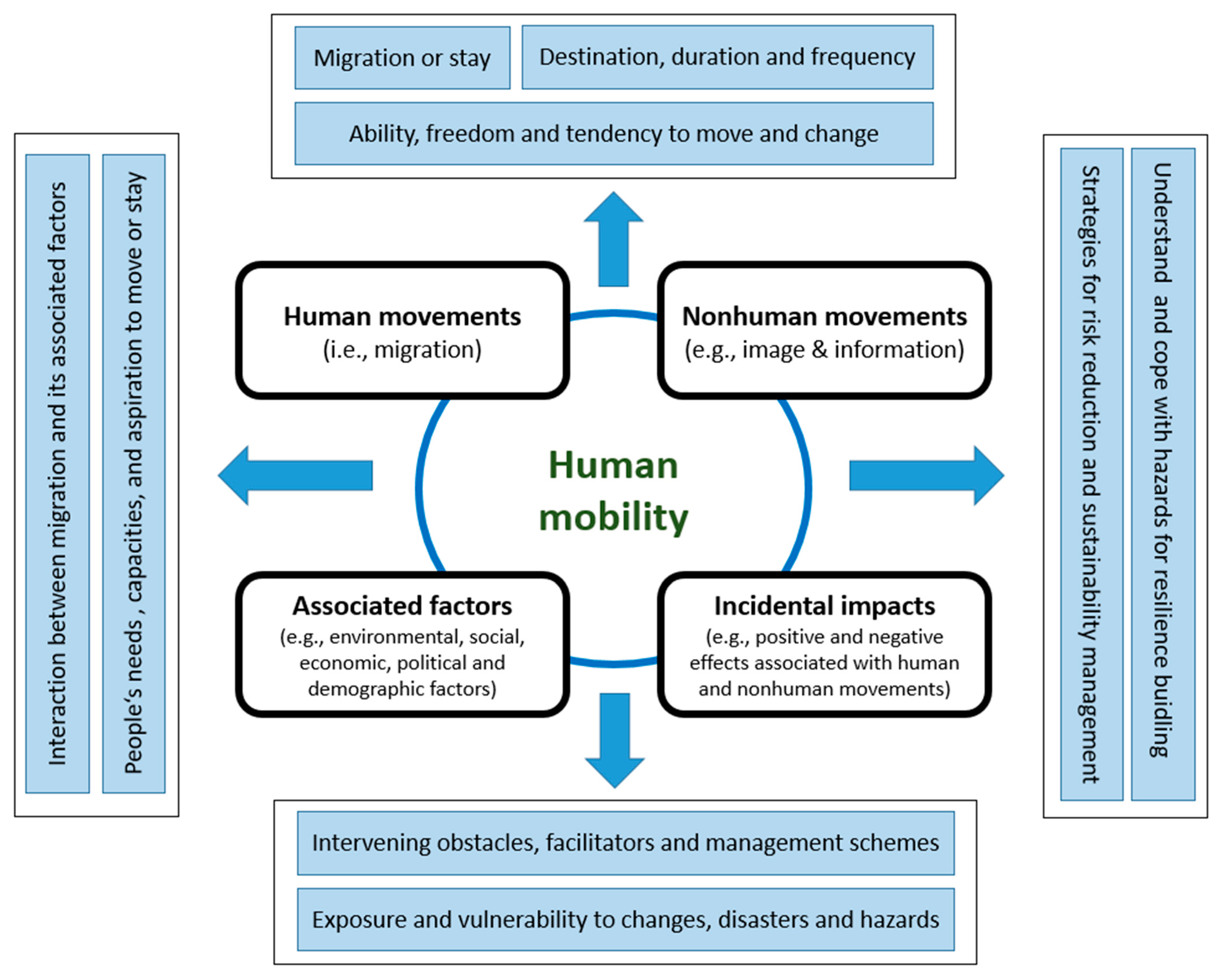
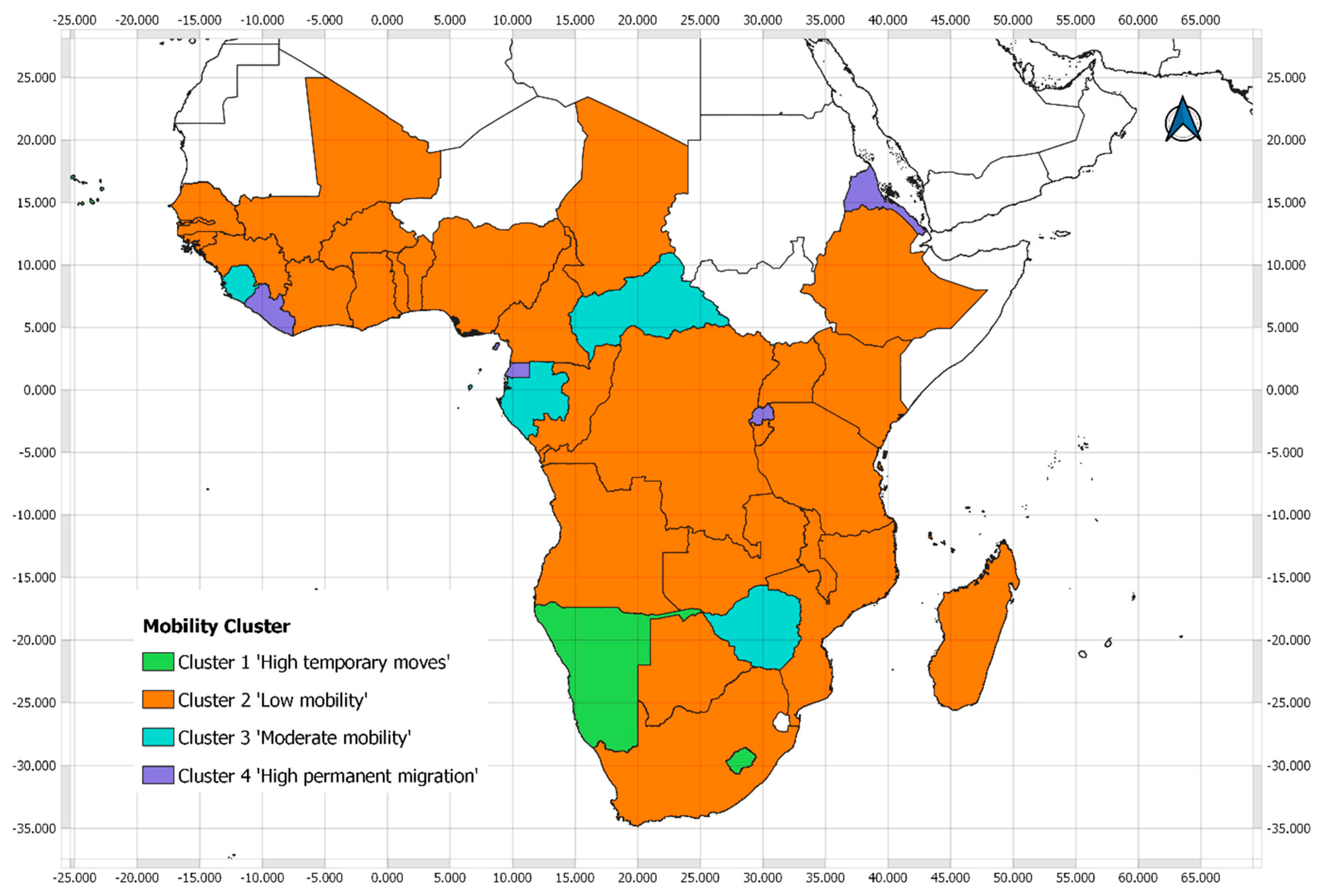
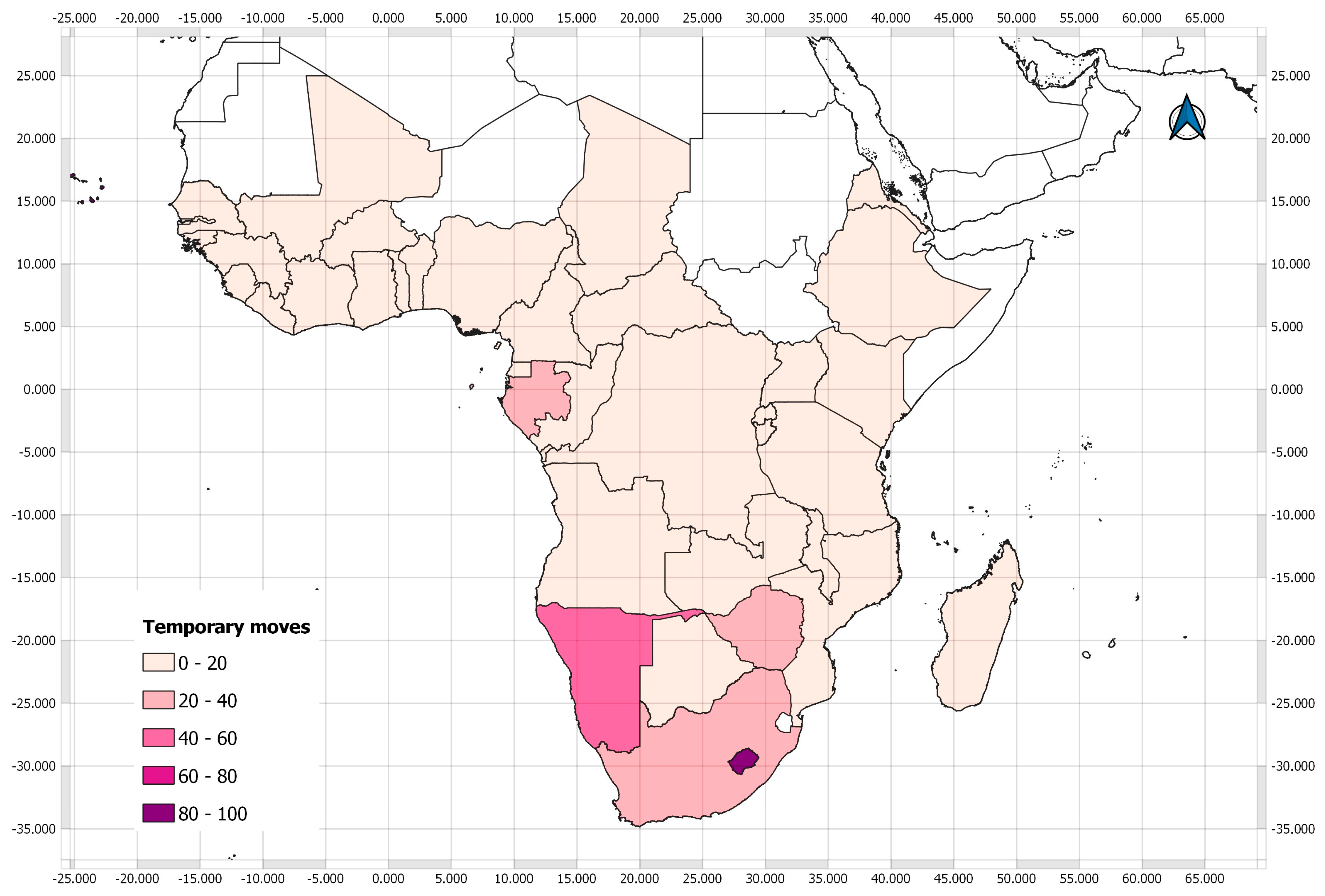
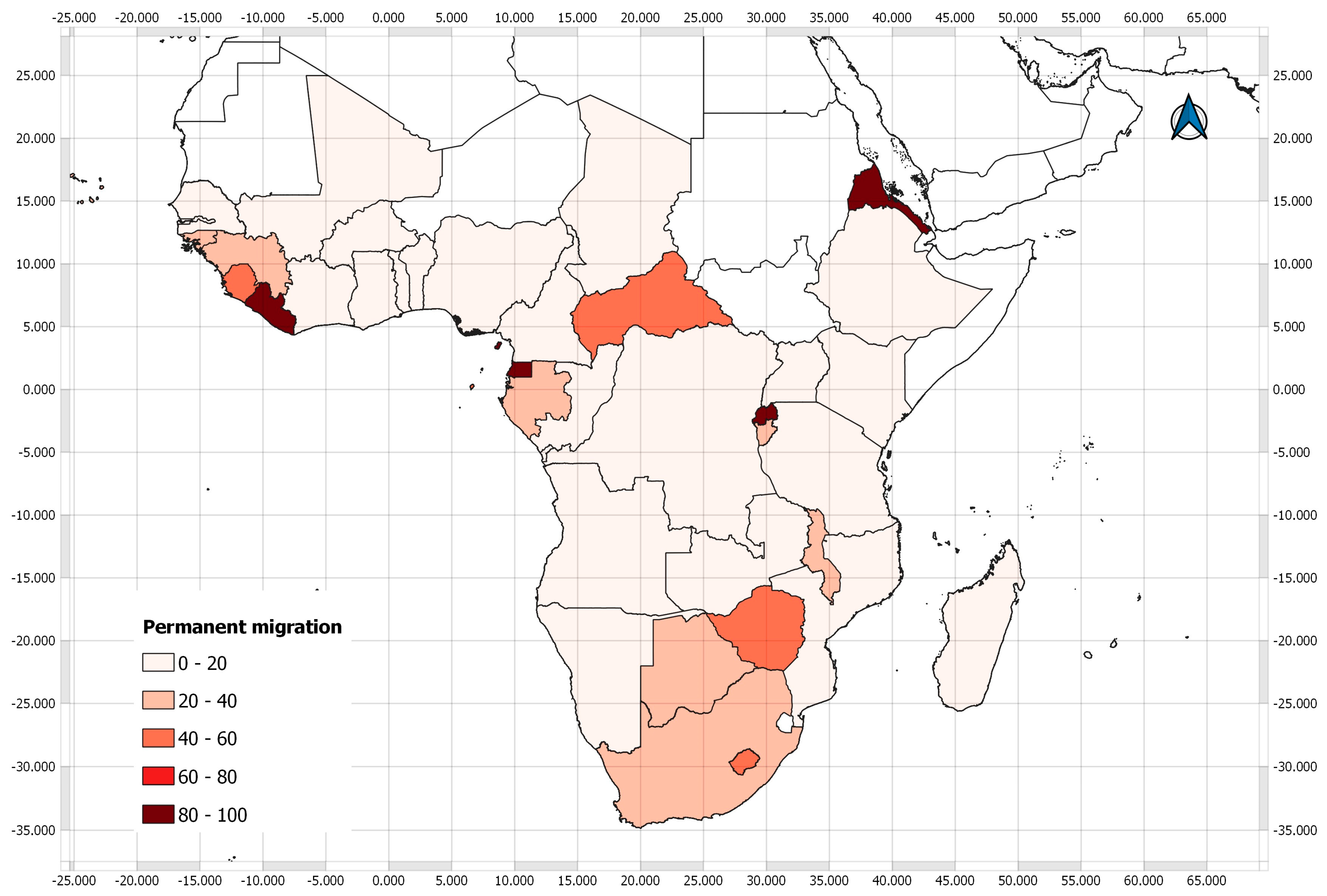
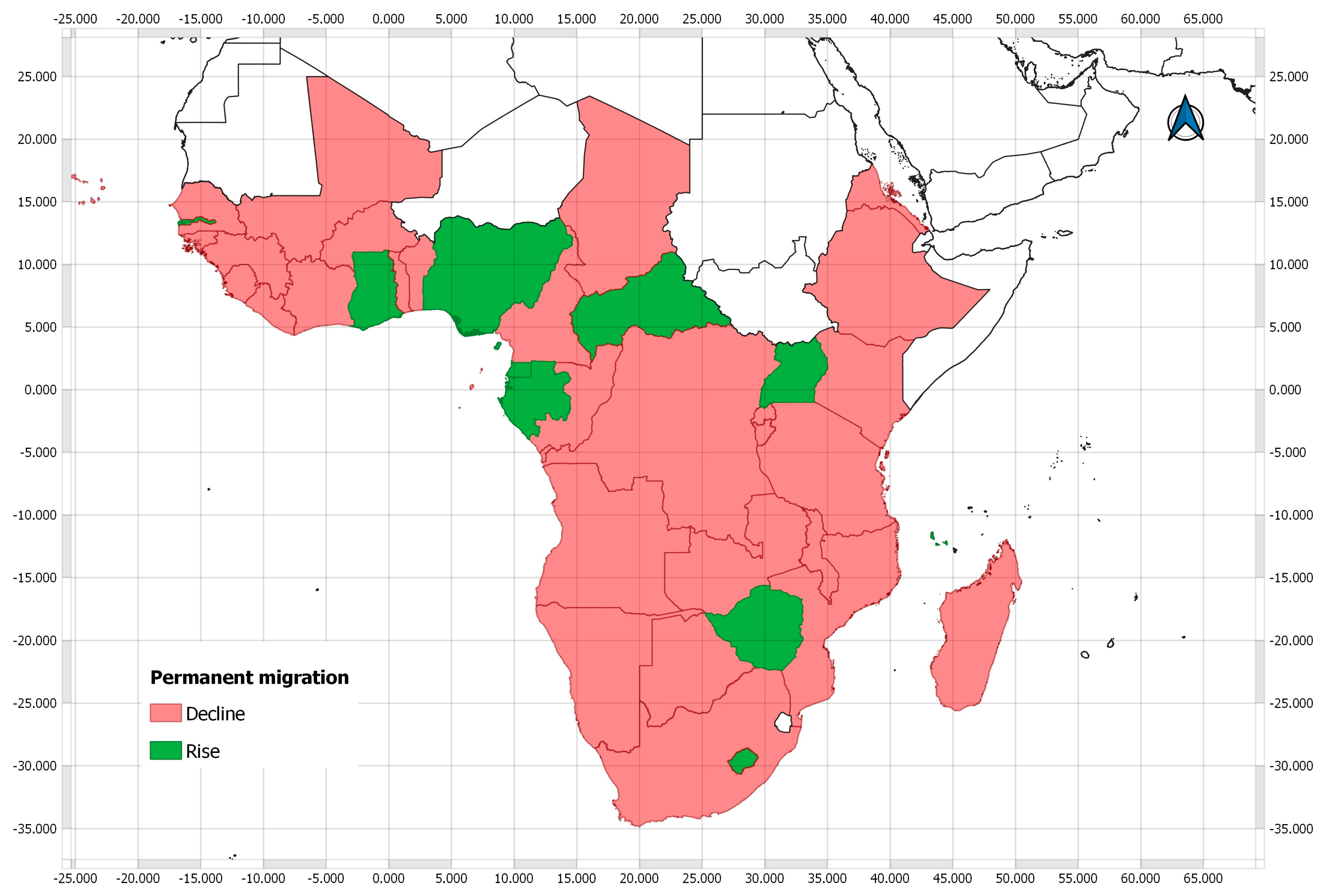
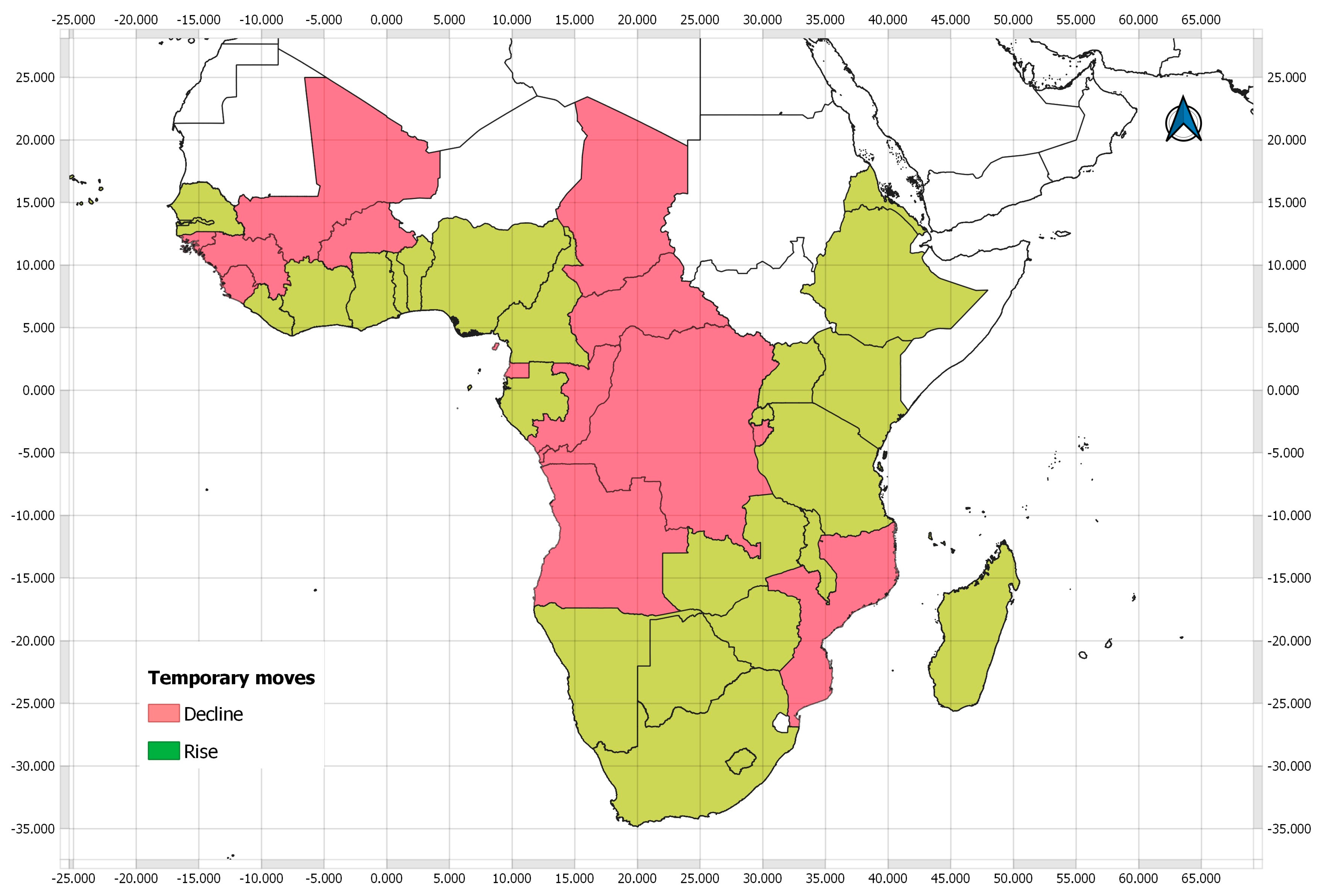
| Variables | Description | Mean | Standard Deviation |
|---|---|---|---|
| Permanent migration | |||
| NM | The absolute value of net migration (i.e., the difference between the number of immigrants and the number of emigrants) of the SSA country from 1995 to 2020, in thousands [45]. | 166.64 | 247.59 |
| NM_pop | The absolute values of net migration are divided by the population size of the SSA country from 1995 to 2020, ranging from 0 to 1. | 0.02 | 0.03 |
| Temporary moves | |||
| Trip | Estimates of the cross-border trips from the SSA country based on global tourism and air passenger traffic statistics from 2011 to 2016 [46]. | 1,303,050 | 2,458,749 |
| Trip_pop | The estimates of the cross-border trips are divided by the population size of the SSA country from 2011 to 2016. | 0.16 | 0.25 |
| Climatic–socioeconomic variables | |||
| Dry extremes | Count of dry extremes (i.e., self-calibrating Palmer Drought Severity Index < −4) within one country of every 5-year interval [48,49]. | 618.45 | 1881.10 |
| Wet extremes | Count of wet extremes (self-calibrating Palmer Drought Severity Index > 4) within one country of every five-year interval [48,49]. | 916.35 | 4131.46 |
| Temperature extremes | Extreme temperature variation is represented by the maximum value of the FAO temperature change of one country of every five-year interval, corresponding to the period 1951–1980 [48,49], in °C. | 1.11 | 0.41 |
| GDP per capita | Per capita gross domestic product, in current USD [48,49]. | 1379.32 | 2266.34 |
| Political stability and absence of violence | Perceptions of the likelihood that the government will be destabilised or overthrown by unconstitutional or violent means, including politically motivated violence and terrorism [48,49]. | −0.54 | 0.88 |
| Average dietary energy supply adequacy | Dietary Energy Supply (DES) as a percentage of the Average Dietary Energy Requirement (ADER). Each country’s or region’s average supply of calories for food consumption is normalised by the average dietary energy requirement estimated for its population to provide an index of adequacy of the food supply in terms of calories [48,49]. | 103.39 | 15.83 |
| Young population | The ratio of the population aged 15 to 34 years to the total population of the SSA country [48,49]. | 0.34 | 0.02 |
| Migrant networks | Number of migrants of the SSA country residing in another country [48,49]. | 392,292.90 | 371,841.20 |
| Variables | Cluster 1 ‘High Temporary Moves’ (N = 3) | Cluster 2 ‘Low Mobility’ (N = 28) | Cluster 3 ‘Moderate Mobility’ (N = 5) | Cluster 4 ‘High Permanent Migration’ (N = 4) | All Countries (N = 40) |
|---|---|---|---|---|---|
| Permanent migration | |||||
| NM | 30.67 ± 39.74 | 169.07 ± 242.46 | 184.40 ± 230.10 | 229.42 ± 350.93 | 166.64 ± 247.59 *** |
| NM_pop | 0.02 ± 0.02 | 0.01 ± 0.01 | 0.04 ± 0.03 | 0.07 ± 0.06 | 0.02 ± 0.03 *** |
| Temporary moves | |||||
| Trip | 1,390,703 ± 937,032 | 1,470,510 ± 2,805,825 | 1,065,223 ± 1,824,744 | 362,374.6 ± 373,359.9 | 1,303,050 ± 2,458,749 * |
| Trip_pop | 0.90 ± 0.32 | 0.06 ± 0.06 | 0.18 ± 0.14 | 0.09 ± 0.06 | 0.14 ± 0.24 *** |
| Climatic–socioeconomic variables | |||||
| Dry extremes | 257.33 ± 460.39 | 748.64 ± 2183.16 | 199.60 ± 585.55 | 501.50 ± 1051.39 | 618.45 ± 1881.10 |
| Wet extremes | 38.00 ± 64.98 | 1255 ± 4899.55 | 197.2 ± 419.66 | 103.50 ± 191.28 | 916.35 ± 4131.46 |
| Temperature extremes | 1.36 ± 0.49 | 1.12 ± 0.38 | 1.05 ± 0.37 | 0.96 ± 0.55 | 1.11 ± 0.41 . |
| GDP per capita | 2216.48 ± 1570.35 | 1056.40 ± 1347.14 | 1850.64 ± 2595.80 | 2422.80 ± 5209.72 | 1379.32 ± 2266.34 *** |
| Political stability and absence of violence | 0.56 ± 0.42 | −0.62 ± 0.84 | −0.51 ± 0.92 | −0.82 ± 0.76 | −0.54 ± 0.88 *** |
| Average dietary energy supply adequacy | 102.52 ± 14.06 | 103.81 ± 16.90 | 102.86 ± 13.17 | 101.79 ± 12.58 | 103.39 ± 15.83 |
| Young population | 0.36 ± 0.02 | 0.34 ± 0.02 | 0.34 ± 0.02 | 0.34 ± 0.03 | 0.34 ± 0.02 *** |
| Migrant networks | 131,585.9 ± 72,482.1 | 459,081.2 ± 382,694.3 | 196,220 ± 239,366.3 | 365,396.7 ± 400,714 | 392,292.90 ± 371,841.20 *** |
| Variables | Permanent Migration | Temporary Moves | ||
|---|---|---|---|---|
| NM (NBM) | NM_Pop (OLS) | Trip (NBM) | Trip_Pop (OLS) | |
| Dry extremes | 1.0001 (0.00004) ** | 0.0001 (0.00005) ** | 0.99994 (0.00001) *** | −0.0001 (0.00001) *** |
| Wet extremes | 0.99996 (0.00001) *** | −0.00005 (0.00001) ** | 0.999995 (2.0976 × 10−6) ** | −3.3850 × 10−6 (2.2314 × 10−6) . |
| Temperature extremes | 1.2822 (0.1924) | 0.1790 (0.2536) | 1.1507 (0.0720) . | 0.1953 (0.0793) * |
| GDP per capita | 1.0001 (0.00003) *** | 0.0004 (0.00004) *** | 0.9999 (0.00002) | −0.00003 (0.00002) |
| Political stability and absence of violence | 0.5829 (0.1039) *** | −0.5728 (0.1197) *** | 1.0617 (0.0560) | 0.0701 (0.0571) |
| Average dietary energy supply adequacy | 0.9704 (0.0079) *** | −0.0280 (0.0111) * | 0.9889 (0.0033) *** | −0.0132 (0.0031) *** |
| Young population | 8.1192 (3.6746) | 3.7861 (4.8267) | 0.0006 (3.3821) * | −8.5789 (3.6824) * |
| Migrant networks | 1.000001 (2.1464 × 10−7) *** | 9.8294 × 10−7 (2.8988 × 10−7) ** | 1.000001 (2.3190 × 10−7) ** | 6.9777 × 10−7 (2.2228 × 10−7) ** |
| Year fixed effect | Yes | Yes | Yes | Yes |
| Country fixed effect | Yes | Yes | Yes | Yes |
| Pseudo R2 (Nagelkerke)/R2 | 0.9717 | 0.7445 | 0.9956 | 0.9941 |
| Constant | 333.7674 (1.3151) *** | −4.8653 (1.6999) ** | 2.3670 × 107 (1.1796) *** | 0.5407 (1.2660) |
| Number of observations | 240 | 240 | 80 | 80 |
Disclaimer/Publisher’s Note: The statements, opinions and data contained in all publications are solely those of the individual author(s) and contributor(s) and not of MDPI and/or the editor(s). MDPI and/or the editor(s) disclaim responsibility for any injury to people or property resulting from any ideas, methods, instructions or products referred to in the content. |
© 2023 by the authors. Licensee MDPI, Basel, Switzerland. This article is an open access article distributed under the terms and conditions of the Creative Commons Attribution (CC BY) license (https://creativecommons.org/licenses/by/4.0/).
Share and Cite
Li, Q.; Samimi, C. Assessing Human Mobility and Its Climatic and Socioeconomic Factors for Sustainable Development in Sub-Saharan Africa. Sustainability 2023, 15, 11661. https://doi.org/10.3390/su151511661
Li Q, Samimi C. Assessing Human Mobility and Its Climatic and Socioeconomic Factors for Sustainable Development in Sub-Saharan Africa. Sustainability. 2023; 15(15):11661. https://doi.org/10.3390/su151511661
Chicago/Turabian StyleLi, Qirui, and Cyrus Samimi. 2023. "Assessing Human Mobility and Its Climatic and Socioeconomic Factors for Sustainable Development in Sub-Saharan Africa" Sustainability 15, no. 15: 11661. https://doi.org/10.3390/su151511661
APA StyleLi, Q., & Samimi, C. (2023). Assessing Human Mobility and Its Climatic and Socioeconomic Factors for Sustainable Development in Sub-Saharan Africa. Sustainability, 15(15), 11661. https://doi.org/10.3390/su151511661






